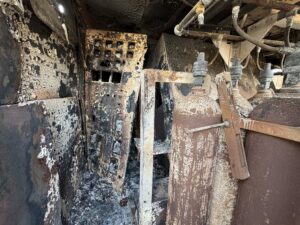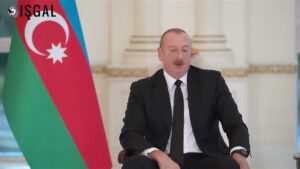“Tarhuna Feels Like a Ghost Town Now.” Civilians in Tarhuna Suffer Following the Libyan National Army’s Retreat
by Lindsey Snell

On June 5, militias affiliated with the Government of National Accord (GNA), a UN-backed interim government based in Tripoli, pushed into Tarhuna following a retreat by the Libyan National Army (LNA), led by Benghazi-based Field Marshal Khalifa Haftar. “It was a humanitarian gesture intended to spare the Libyan people further bloodshed,” Major General Ahmed al-Mismari, spokesman of the LNA, said of the retreat.
The LNA took control of Tarhuna in April 2019 as part of a larger offensive aimed at capturing Tripoli from the GNA. In December 2019, following an invitation from Fayez al-Sarraj, the prime minister of the GNA, Turkey began to send weapons, Turkish military personnel, and an estimated 13,000 Syrian militants from the Turkish-backed, so-called Syrian National Army (SNA) to Libya to support the GNA. SNA militants accompanied GNA forces when they entered Tarhuna.
“The Turkish intervention changed everything,” an LNA source, who wished to remain anonymous, said. “The Syrian mercenaries, the heavy equipment, including Turkish naval vessels and UAVs (armed drones)…it was more than we were prepared for. The retreat came after mounting pressure from the International community. Tarhuna was under attack on all fronts, and we saw that taking a stand in a surrounded city would put the lives of 160,000 civilians at risk.”
A few hours after the GNA officially took control of the city, Husam Ali, a 26 year-old accountant in Tarhuna, appeared online for the first time in months. “I haven’t had the internet in more than 60 days,” he said. “We’ve had power cuts, water cuts. It’s done from the outside, by the GNA. It’s revenge on Tarhuna, because Tarhuna is seen as being loyal to the LNA. The city is so empty, it feels like a ghost town now.”
According to the LNA source, more than 37,000 civilians were displaced from Tarhuna and resettled in Sirte and further east. “The GNA was using a submission by starvation strategy in Tarhuna. They cut off food and medical supplies. They cut electricity from the main power grid, and phone and internet services, as well. Anything sent from Benghazi, from ventilators to combat the covid-19 outbreak, to fuel tankers, was targeted. We couldn’t let the people of Tarhuna suffer any longer,” he said.
Husam Ali described the situation in the hours after the GNA and Syrian militants appeared in Tarhuna. “I just had to go hide my family’s valuables,” he said. “I haven’t had to do that in a long time. Right now, the militias are two kilometers away from me. They’re stealing everything. They stole chickens from an old woman, left, and then came back to steal her earrings.” Almost immediately after GNA-aligned forces took control of Tarhuna, pictures and videos of the GNA and SNA militants looting flooded social media. Many images were ones the militants had taken and proudly posted themselves. In a particularly gruesome photoset, militants posed with zoo animals they’d slaughtered, including gazelles and a lion.
For Ali, the looting and destruction was a bitter reminder of years spent under militia rule before the LNA took control of Tarhuna. “We had economic difficulties, but life here was much better when the [LNA] was in control. Things were becoming stable again, and we were rebuilding,” he said. Years of war scarred Tarhuna, and the reconstruction process has been slow. On June 7th, two days after taking control of Tarhuna, GNA militants broke into a mall, looted its contents, and set it on fire.
“To see the things these militants have done here, like burning down our mall, it’s sickening,” Ali said. “The Syrians are already famous for how well they steal here. They will go to a door and announce to the people inside, ‘It’s safe, open the door,’ and when the people open the door, the Syrians steal everything inside. They have even stolen traffic lights from the city. It’s funny and sad at the same time.”
A source from the Faylaq al-Majd faction of the SNA who’d been in Tarhuna confirmed the allegations of looting. “Yes, we looted. We have looted in Tripoli, too. They don’t pay the salaries they promised us, so this is how we make a living,” he said. “If we see something heavy or worth it, we take it. It’s a normal thing.” He sent three photos of a civilian home in Tarhuna he’d looted. The rooms had been ransacked.

“They’re not letting us stay in homes in Tarhuna, so we will stay in the Yarmouk Camp for some time,” the SNA source said, referring to a military camp south of Tripoli that was captured by the GNA from the LNA in late May. “It’s a shame, because I had a beautiful home in Tripoli.” The SNA militant had been housed in a spacious, well-appointed family villa in Tripoli, abandoned when its civilian occupants fled the fighting in their neighborhood. The majority of SNA militants in Libya are occupying civilian homes. They’ve looted those, too.
On June 10th, Husam Ali sent another update. “The Rada forces have come, and most of the Syrians have gone,” he said. The Rada (special deterrent forces) bill themselves as police force. They technically operate directly under the GNA’s Ministry of Interior, but they function autonomously. Their leader, Abdel Rauf Kara, is a Salafist, and as such, his militia has routinely targeted homosexuals, alcohol drinkers, and drug users. They’ve been accused of countless kidnappings and extrajudicial executions. “They are a very bad group, but they are more disciplined, and with them here, there might be less destruction and theft,” Ali said.
The SNA militant who went to Tarhuna confirmed Rada’s arrival in the city. “They’re like ISIS. They’re at the checkpoints now, and they’re even checking the cars for cigarettes,” he said. “The other Libyan militias seem to hate them.”
“Rada is feared by the other militias,” the LNA source said. “They’re better trained, and they’re equipped with US-made weapons. And they’re extremists. They have fought ISIS, but they also have a terrorist mentality.”
A day later, Ali wrote again to say he’d been wrong to be optimistic. “The militias have been burning homes here,” he said. “They’re homes owned by people believed to be loyal to the LNA. And they’re still stealing everything they can.”
After entering Tarhuna, GNA forces claimed to uncover mass graves in the city, immediately pointing to the LNA and the Kaniyat, a local militia, as the responsible parties. In 2012, the Kaniyat, a militia run by the Kani family, took control of Tarhuna. Before the LNA’s push for Tripoli in April 2019, the Kaniyat were loyal to the GNA.
The LNA source said, “The LNA entered Tarhuna in April 2019. We didn’t conduct any mass executions of any kind. Otherwise, why wouldn’t we have done so to the Syrian mercenaries, since the Geneva Convention doesn’t offer them protections as prisoners of war? It’s interesting that the GNA found them so quickly, since there probably wasn’t a sign that said ‘mass graves’ on them. They were clearly the perpetrators.”Denying any LNA involvement, LNA spokesman Major General Ahmed al-Mismari said he welcomed the UN’s call to investigate the mass graves and said that the LNA had been monitoring the GNA’s violations against civilians.


